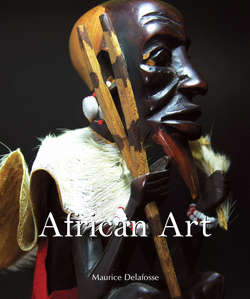Читать книгу African Art - Maurice Delafosse - Страница 12
На сайте Литреса книга снята с продажи.
Development of Negro Civilisations in Antiquity
Paucity of Historical Documentation
ОглавлениеI was obliged in the course of the preceding chapter to almost exclusively use the hypothetical mode. In this one and the following, I will again be forced to have very frequent recourse to it, so rare are the documents on which we can rely with sufficient confidence to make deductions from them. Until now, in fact, Negro Africa has revealed to us no monument except for some ruins which do not recount their history or their creators, and some tombs which might go back from fifty to five thousand years, in which everything is found except precise indications, unless an Arabic inscription informs us that we have to do with modern burial places. The Negroes have written nothing with the exception of rare works in Arabic, the most ancient of which we possess dates from the 16th century. Marginally copied one from the other, they do not contain more than a few pages on the history of the country and whatever may be true is obscured by legend and the pains taken to relate everything to Islam and the family of Mohammed.
Much more numerous and rich are the traditions conserved orally among the natives, but they become very confused as soon as they relate to facts going back several centuries and, without in any way denying their value, this source of information cannot be used except with the utmost prudence.
From the Greek and Latin authors, bits of documentation, often contradictory and supported by nothing very solid, can at least furnish some vague and incohesive indications, sometimes a few benchmarks. The names of the countries, localities, and peoples are generally difficult to identify and when they are examined impartially it is found that they all refer to countries, localities and peoples belonging to North Africa and not to Negro Africa. When, by chance, geographical or ethnical information seems to refer to the Negroes or to their country, it is drowned in an amalgam of impossibilities or obscurities from which it is extremely difficult to obtain any light.
For the period of the Middle Ages, we are a little better informed by Muslim geographers and historians of Berbery, Spain, Egypt, and the Arabian Peninsula, and by some works later re-edited in Arabic by the Sudanese, to which I have alluded above. This information is also very imperfect and entirely fragmentary, being limited to the borders of the Sahara and the west coast of Africa which were in more or less direct relations with the Arabs of the Mediterranean or the Gulf of Oman. Concerning the more distant Negro peoples, those of Guinea, of the Congo, of southern Africa, there is almost absolute night up to the day when they began to be visited by Europeans, that is to say, up to the 15th century CE. In the preceding chapter we saw how much we are permitted to conjecture as to the situation of the African Negroes at the time of Herodotus. We have also seen – according to the testimony of this author – that Egyptian civilisation was not without influence on that of the Negroes in the region of Meroe. It may be admitted that the influence of ancient Egypt went still further and penetrated even into the upper part of the valley of the Nile. Perhaps, gradually, it made itself felt as far as the Great Lakes, as certain artistic manifestations seem to testify by recalling the manner and processes of ancient Egypt. It is even possible that, transmitted indirectly from people to people, infiltrations of an industrial or religious order, having their point of departure at Memphis or Thebes, had gained the farthest lands of the Nile, probably without ever having been in direct relations with Egypt, such as certain regions of the Gulf of Benin or the neighbouring lands.
Head (Sokoto), c. 200 BCE-20 °CE.
Nigeria.
Terracotta.
Private collection.
Sokoto sculptures are sometimes limited in ornament. The delicate features and heavy brow combined with a fine beard offer a severe aspect. The thin pottery walls of this head bear witness to a highly developed technique.
